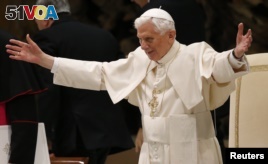February 13,2013
VATICAN CITY — Thousands of people crowded into St. Peter's Basilica at the Vatican as Pope Benedict XVI led his last scheduled mass, and hundreds more gathered around large television screens in the square outside.
A choir sang as the 85-year-old pontiff entered the church, walking on his own, his first public appearance since announcing his resignation earlier this week. Looking somewhat frail in his ceremonial purple robe, he boarded a moving platform to travel down the long center aisle as some Roman Catholic cardinals, one of whom may replace him as pope next month, formed a procession behind him.

Pope Benedict XVI opens his arms in greetings as he arrives to lead his Wednesday general audience in Paul VI hall at the Vatican, February 13, 2013.
His voice raspy but clear, Pope Benedict offered his thanks to everyone who had helped him during his papacy.
During the season of Lent which begins today, we renew our commitment to the path of conversion, making more room for God in our lives.
— Benedict XVI (@Pontifex) February 13, 2013
He received long rounds of applause at the beginning and end of the service. His chief assistant spoke briefly, saying there was “a veil of sadness” over the service, and thanking the pope for being what he called a “simple and humble worker in the vineyard of the Lord.”
That was what Pope Benedict had promised to do on the day he was elected pope eight years ago.
The pope led the Ash Wednesday mass two days after he announced his resignation, saying age and physical frailty were preventing him from fulfilling his obligations as he would like to. The Vatican had publicly acknowledged for the first time that the pope, a German formerly known as Cardinal Joseph Ratzinger, has a pacemaker.
It is the first papal resignation in nearly 600 years, and many people did not even know it was possible.
The pope will hold a final public audience on the balcony at St. Peter's Square on February 27, and will retire the next day.
About two weeks later, Roman Catholic cardinals will convene to choose his successor. Officials say the new pope is expected to be named by Easter, March 31, and that Pope Benedict will play no role in the selection.
A man's story
The chief of Vatican Radio's English Section, Sean-Patrick Lovett, says the pope's resignation “redefines the papacy,” focusing on the human rather than the divine-connection element.
“This is not a pope story, this is a man's story, Lovett said.” This is an old man, who is nearly 86, with a sense of responsibility looking at who he is relation to the office that he holds and saying, 'I have to be honest, I cannot do this anymore.'”
Lovett says the move sets a standard for future popes, but does not necessarily signal any major policy changes will come under the new pope.
“The Catholic Church is not about change, it is not a democracy," he said. "It is about continuity, and doctrine is very unlikely to change no matter who becomes pope.”
There is lots of speculation on who that might be, particularly whether it might be someone from Africa or Latin America, which, combined, are home to more than half the world's Catholics. But Lovett says the same speculation was heard during the past 35 years for each of the three papal transitions he has covered.
Pope Benedict's rule has been concerned with the church's child sex abuse scandal that began long before he ascended to the papacy. Last year, his butler was found to be the source of leaked documents alleging corruption in the Vatican's business dealings. Pope Benedict also has been criticized for inflexibility on church dogmas.
In contrast, Pope Benedict has received praise for instituting a financial watchdog for the Vatican's financial dealings and becoming the first pope to communicate with followers via social media.